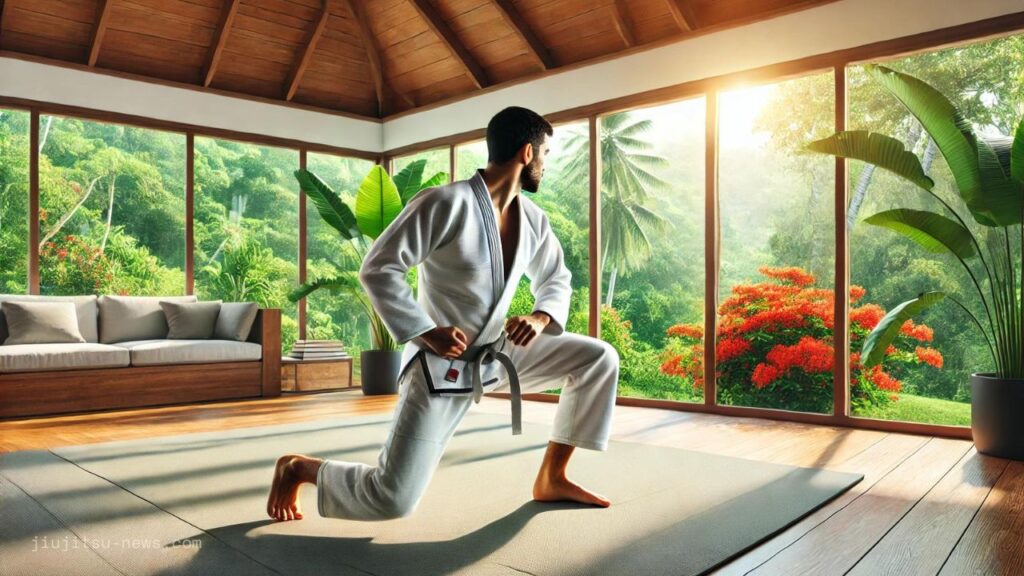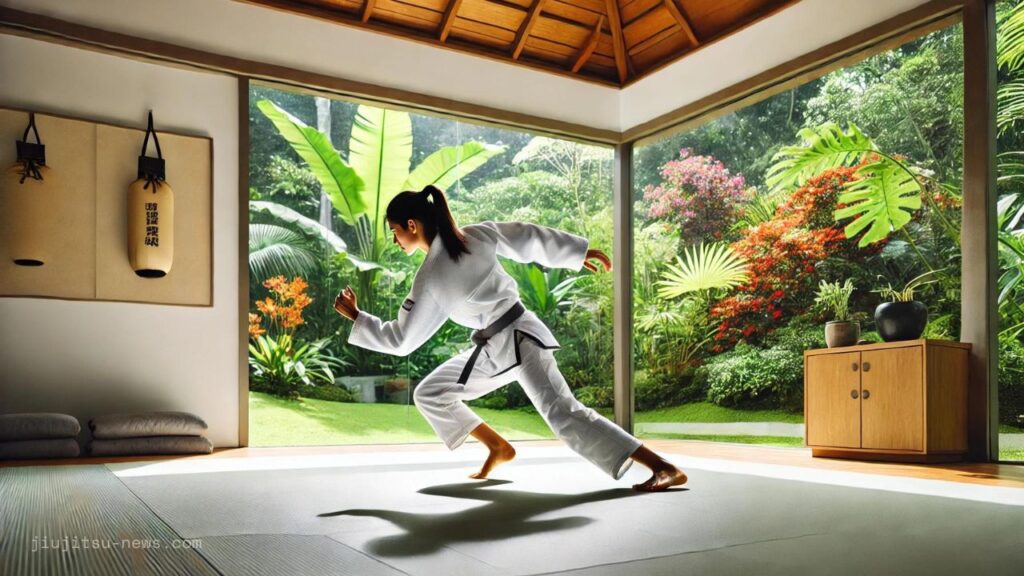Do you want to train in Brazilian Jiu-Jitsu without going to the gym? The fast-paced nature of our era has prompted many people to look for ways to study BJJ at home.
While this strategy can only partially replace a dojo experience, it can help you improve your Brazilian Jiu-Jitsu skills and give you with a more flexible training schedule.
This book will help you set up your training environment, develop an effective plan, stay motivated, and make the most of your home BJJ practice.
- How to Learn Jiu-Jitsu at Home: Clear Actionable Steps
- 1. Understanding the Basics of BJJ
- 2. Setting Up Your Home Training Space
- 3. Developing a Training Plan
- 4. Learning Through Online Resources
- 5. Key Solo Drills and Exercises
- 6. Enhancing Flexibility and Conditioning
- 7. Tracking Your Progress
- 8. Staying Motivated and Consistent
- 9. Transitioning Back to the Dojo
- Conclusion
How to Learn Jiu-Jitsu at Home: Clear Actionable Steps

To learn Jiu-Jitsu at home, consider signing up for online courses, acquiring the necessary equipment, and preparing a suitable training space.
Whether you aim to stay fit, spend more time with family, or enhance your Jiu-Jitsu skills, the following suggestions will help you improve your grappling skills from the comfort of your home.
1. Understanding the Basics of BJJ
- Learn Key Positions and Submissions: Start with fundamental positions such as guard, mount, and side control. Then, learn essential submissions like the armbar, triangle choke, and rear-naked choke.
- Watch Instructional Videos: Use online resources to watch videos that break down each technique step-by-step. Focus on understanding the mechanics and purpose of each move.
- Read BJJ Books and Articles: Supplement your video learning with books and articles that provide in-depth explanations and tips.
2. Setting Up Your Home Training Space

- Choose a Safe Training Area: Find a room or space with enough room to move around comfortably. Ensure it’s free from sharp objects and hazards.
- Invest in Mats: Purchase mats to provide a safe, cushioned surface for practicing moves.
- Install Mirrors: Use mirrors to check your form and technique while training.
- Minimize Distractions: Ensure your training space is free from distractions to maintain focus during your sessions.
3. Developing a Training Plan
- Set Clear Goals: Define what you want to achieve with your home training, such as improving flexibility, learning new techniques, or building strength.
- Create a Schedule: Plan your workouts for specific days and times each week, such as Monday, Wednesday, and Friday.
- Structure Your Sessions: Each session should include a warm-up, specific drills, technique practice, and a cool-down. Start with basic movements and gradually incorporate more complex techniques.

4. Learning Through Online Resources
- Find Reputable Online Courses: Enroll in online BJJ courses or follow well-known instructors on platforms like YouTube.
- Join BJJ Forums and Communities: Engage with other BJJ practitioners online to share tips, ask questions, and receive feedback.
- Use Multiple Learning Formats: Watch videos, read articles, and participate in online discussions to diversify your learning experience.
5. Key Solo Drills and Exercises
- Practice Solo Drills: Incorporate drills like bridging, shrimping, technical stand-up, and forward and backward rolls into your routine. Each drill targets different skills essential for BJJ.
- Repeat and Refine: Consistently practice these drills to build muscle memory and improve your technique.
- Track Your Drills: Keep a journal or log to record your practice sessions and track improvements.
6. Enhancing Flexibility and Conditioning

- Incorporate Stretching: Include stretches like the lunge hip flexor stretch, 90/90 hip stretch, and hinge stretch to improve flexibility.
- Conditioning Exercises: Add push-ups, squats, and burpees to build strength and endurance.
- Balance Your Workouts: Combine flexibility and conditioning exercises with BJJ drills to create a comprehensive training routine.
7. Tracking Your Progress
- Maintain a Training Journal: Record techniques practiced, strengths, and improvement areas.
- Video Recordings: Regularly record your practice sessions to analyze your form and technique.
- Set Benchmarks: Create specific milestones to achieve and celebrate small victories to stay motivated.
8. Staying Motivated and Consistent
- Set Achievable Goals: Break down larger goals into smaller, attainable steps.
- Join Online BJJ Communities: Connect with other BJJ enthusiasts to share progress and stay inspired.
- Find an Accountability Partner: Partner with someone who can keep you accountable and motivated.
- Keep Your Routine Varied: Mix up your training sessions to keep them exciting and avoid burnout.
9. Transitioning Back to the Dojo
- Apply Learned Techniques: Integrate the skills and drills practiced at home into your dojo sessions.
- Communicate with Instructors: Share your home training progress with your instructors and seek their feedback.
- Gradual Transition: Return to dojo training by combining home and in-person sessions.
- Choose the Right Dojo: Find a dojo with experienced instructors and a positive training environment to continue your BJJ journey.
Conclusion
Learning Brazilian Jiu-Jitsu at home is a challenging but rewarding journey.
Understanding the basics, setting up a proper training space, and following a structured plan can help you progress significantly.
Utilize online resources, practice essential solo drills, and focus on flexibility and conditioning. Connect with the BJJ community to track your progress and stay motivated.



